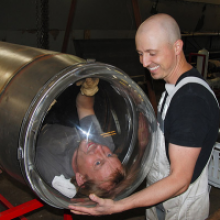Denmark might become the 4th space power

What do you get when you take a tag team of 20 Danish volunteers, 50,000 euros of private funding, a 2-foot diameter 32-foot long rocket, a former NASA scientist and an engineer that previously has built his own working U-boat submarines for fun? You get the HEAT1X-Tycho Brahe rocket built by the non-profit Copenhagen Suborbitals, which is intended to launch a man into space and bring him back safely.
No, this is not a joke; these guys are serious and are planning to launch their first test flight Tuesday, Aug 31, in the Baltic Sea.
Now, maybe you don't understand what it would mean if they eventually switch from test-dummies to humans and are able to launch a person into space from their rocket. This would mean that Denmark would become the fourth country in the world to join the elite club of nations able to launch a human into space — along with the United States, Russia and China — and they would be the first group to do so without any government support.
Simply put, this is awesome.
How can 20 guys with $70,000 send a man into space when our space agency, NASA, needs $450 million for each space shuttle launch and the shuttles themselves cost about $1.7 billion each — five shuttles = $8.5 billion total. Well, while there is the very valid argument that the shuttle does quite a bit more than this manned amateur rocket, Copenhagen Suborbitals has proved just how much can be accomplished with a dream, the right skill set and a lot of hard work and have given us a peek at what can be done when government bureaucracy is not involved in an engineering solution to a problem. They may have revealed to us just how complex and overpriced our space industry is today because by my calculations they're lifting 1/200 as much weight as the shuttle can for 1/5000 of the cost — that's about a 30 times lower cost-per-pound overall.
So, looking at the state of space travel in the United States today, you may or may not realize that the space shuttle will be retired sometime early next year. That means that for at least a few years, our astronauts will only be able to get to the International Space Station by hitching rides with the Russians, who will have a monopoly on the human spaceflight market. Now, I believe that this is a sad state of affairs, but what's done is done. If the people and government of the U.S. had wanted to not lapse in our human spaceflight abilities, they needed to fix the problem with increased NASA funding years ago for the design of a new space vehicle and not the unfunded President Bush "Vision for Space Exploration" would not have done anything to fix this problem.
On the upside though, the U.S. has not lost the innovative engineering spirit that got us to the moon in the 1960s. We have companies like SpaceX, Orbital Sciences, Boeing, Armadillo Aerospace and others that have all proposed newer, cheaper space vehicles. The issue is that while President Obama proposed a new, more cost-efficient plan for NASA this year and even made some amendments to the plan to appease critics, congress is busy tearing that plan apart and building their own NASA budget. This budget intends to keep every worker on the current rocket assembly lines employed — doing nearly the same job.
This isn't how progress happens.
All we have to do is look at high-speed advances in the tech industry to realize that a good competitive business is naturally a cutthroat business where new ideas and the best, safest, and cheapest device tend to win.
The problem is we have a team of senators and representatives doing rocket design work. Personally I don't believe that a group consisting of many lawyers and political scientists, an economist, a veterinarian and some businessmen should be redesigning the well-defined plan set forth by the managers and engineers at NASA by mandating various features of the next space vehicle that will prove beneficial to each of their constituencies.
All they are doing is increasing cost and decreasing usability of the eventual government space vehicle, while at the same time they're paying for it by stripping money from the program designed to competitively develop a new space rocket to service the space station, the COTS program.
Seriously Congress, let the engineers and scientists do their job and do the right studies to design a new and improved spacecraft and then give them the money to build it as you did in the 1960s. Otherwise we'll really look bad when the world realizes that 20 guys in Denmark have brought their country into the space age and a dozen leaders in the U.S. have caused an 18,000-employee government organization to lag behind a low-cost, privately funded space shot.

No comments available.
Add new comment